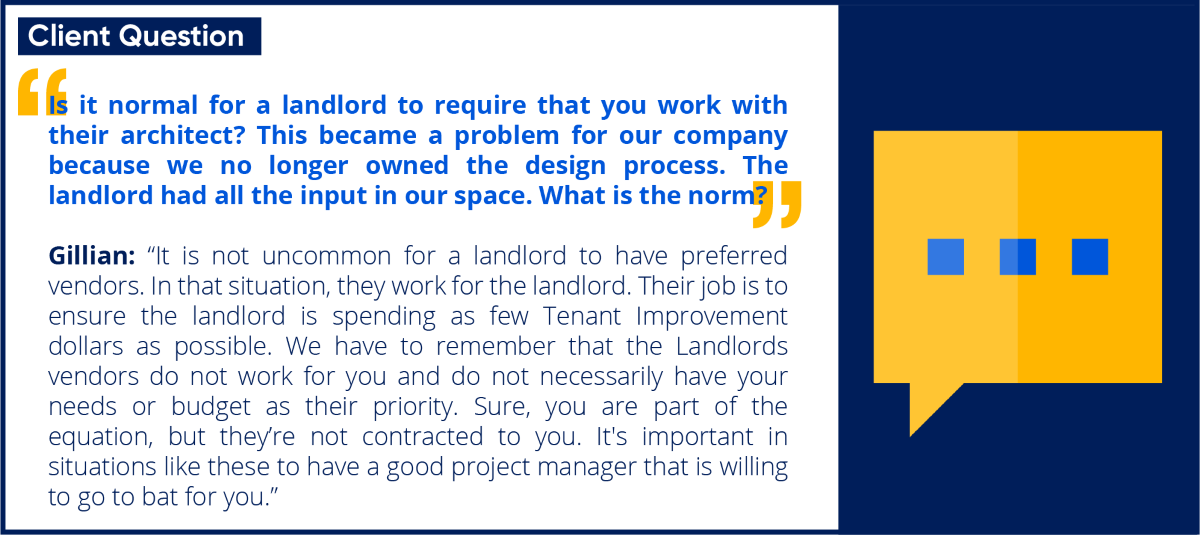If you have ever been through a personal move, then you know the stress that can come along with it. Now, multiply that experience by the number of employees in your office. The relocation process is long, tedious and can be detrimental to your business if handled poorly. It impacts the company profoundly from both a financial perspective and from a human perspective. You’ll have to consider your changing business needs to determine your requirements for growth, how much space you need per employee, your recruiting pool and current employee commute times to find the right location. You’ll need to agree on a workspace design that’s functional, in budget, and yet also helps your business to recruit and retain talent. You’ll even need to determine who will sit where and make sure the movers put each box in the correct location.
It can be a lot. But, when the process is managed well, there is little to no disruption to your business operations. Your people will enter the new space on the first day with their belongings in place and their computer setup. That is, when the process is managed well.
At Cresa, we have been through this process thousands of times and we’ve learned a few things along the way.
Here are our tips for avoiding all the pitfalls of a corporate relocation.
Allow enough time
One of the largest pitfalls is thinking that you have all the time in the world and starting the process too late. A standard 10,000 square foot office project takes between eight and 12 months. If you are building (in Colorado) you can expect the process to take about four years.
That may seem like a long time, but by the time you get your team together, identify your strategy and complete the design process, 12 months can slip by in the blink of an eye. Set your team up for success by starting the process early.
Build an experienced team early
Now that you have allocated enough time, it’s time to put the right team in place. This should include internal team members, external partners and external influencers.
Your internal team members or what we like to call “change champions” are typically the people who have a pulse on your organization. Invite them to be part of the process, without promising that they will get to make the final decisions. This will establish a tone of collaboration and allow you to get the general sense of what your employees are saying and feeling about their workspace. Your internal team should include the CEO, CFO, HR and IT professionals among others.
Your external team will likely include a tenant representation broker, project manager, architect, interior designer, engineer, general contractor, furniture vendors, IT consultants and more. These people/ teams of people are your advocates. Make sure you choose people that have your business’s best interest at heart.
External influencers come into play after the site selection process. This includes your landlord, the landlord’s broker, other tenants in the building, etc. You might not initially consider them as part of your project team, but they will have an impact on your end result.

Have a strategy, a plan and a budget
Once you have the right people in place, make sure you ask the right questions. How many employees do you have? How do you use your current space? Do you allow employees to work from home? If so, do you still need as much space? What is your growth forecast for the next two to ten years?
If you’re on a standard five to seven-year lease, rents in Denver have risen roughly 30 percent since the last time you signed a lease. Unless you can absorb that kind of increase you are looking at having to do some serious workplace strategy and efficient space planning to make up for that increase.
Most of our clients are not prepared for the magnitude and scope of the entire project budget. As such, it is important that your budget accounts for total project cost, not just the rent. The best way to avoid embarrassment when getting budgets approved is to make sure you have carefully considered all items not just rent. Make sure your budgets include rent, and additional rent (HVAC, maintenance and facility maintenance expenses) capital expenses for furniture fixtures and equipment as well as expendable items such a move costs.
Understand your workplace
Your physical space is an extension of your business. Is it getting you closer to your business goals and objectives or distracting from it? Your space has an impact on your employees and if you ignore it doesn’t have a neutral effect, it typically has a negative one.
Overlooking this step, or assuming you know how your employees feel is a pitfall. But, selecting the right internal team can help you avoid it. One way to find out what people like and what they don’t is to use is the “Trash or Treasure” exercise. What sparks joy in your workspace? Put a poster on the wall and allow employees to list the things they treasure about their current workspace (the coffee maker, their standing desks, etc.) and things they would trash (their uncomfortable chairs, the lack of windows, etc.).
Think about how technology has evolved. If it’s been seven to ten years since your last office move, chances are your technology is no longer serving your needs at the highest capacity.
This is also the time to think about your culture and company branding. What are the ways you could live out the company mission better? How can you incorporate your values into the new space? Ask these questions early on so that you can utilize this insight as you select your architect and designer and begin to make decisions for your new workspace.
Align expectations with reality
Finally think about what really matters to your business. What metrics are you using to determine success?
We understand that you want a Google-style office, but we also want your business to thrive. It’s important to have someone that can push back on your behalf and keep your project on budget.
The key to aligning your employees’ expectations is to over communicate throughout this entire process. Change can be hard for people, so it is critical to set a positive tone for the move early on.
Approach the market with strength
Once you’ve determined what your options are, go into the market from a position of strength. Often times, we find that the market has been over-hyped by the landlords and their brokers so cast a skeptical eye towards market conditions and don’t believe the hype you hear about the market. It all really has to do with your context. Depending on your requirements there are usually dozens of of options available to you within your parameters for space and out there. So, focus on what is happening with your company and what can you afford and the the market is yours for negotiation just remember to keep multiple options in the negotiation to protect against unforeseen actions in the market which you cannot control such as other tenant leasing.
Design and construct to budget
Remember that budget that we set at the beginning. Yeah, let’s go back to that.
Design and construction is the easiest place for a corporate relocation project to slip off the rails. Make sure your team of architects and designers understand your budget and your design esthetic and works with the general contractor throughout the design process to achieve both. The cost of construction has skyrocketed over the past several years And it’s easy to underestimate the costs of construction simply because something looks nice. Have someone on your team that understands your drivers for design and construction and will push creativity and controls into the process to achieve your goals.
The move: Don’t drop the CEO’s monitor
Above all, don’t drop the CEO’s monitor. This one comes from experience. There are literally thousands of hours into a typical project and on the final day, if one of the movers drops the CEO’s monitor it will be a failed project.
All jokes aside, moves are complicated. They can be costly in both time and money. So, set your company up for success from the outset by making sure you have the right team of advocates in place to ask the right questions and keep your project on time and on budget.
This blog post was co-written by Gillian Baikie and Bill Baldwin.



